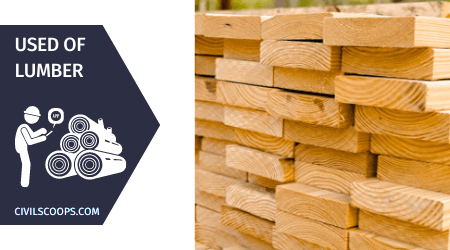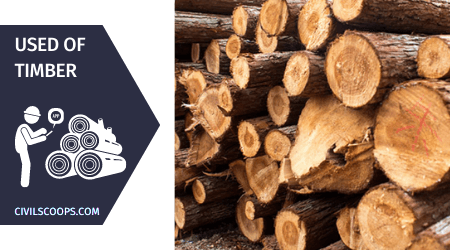What Is Timber ? | What Is Lumber ? | What Is Lumber Used for ? | Lumber Vs Wood | Difference Between Lumber and Timber | Standard Wood Size | What Is Timber Used for ?

Table of Contents
What Is Timber?
Timber is a phrase that has numerous meanings and is often used interchangeably with the phrase lumber in many parts of the world. Timber usually refers to either unfelled trees or harvested trees that have been left with their bark or other traits for aesthetic reasons.
Timber is a flexible raw material with a number of benefits that allow it to be used in a variety of applications.
What Is Lumber?
The term “lumber” refers to trees that have been felled. It’s far more primitive than timber; in most cases, the bark will still be present. Lumber is less processed than timber, which is an easy way to understand the overall difference between the two.
Also Read: Difference Between Cement Plaster and Gypsum Plaster
What Is Lumber Used for?

- Uncut lumber was first used for fire and heat generation, and most families in underdeveloped countries still utilize firewood as their major source of fuel. Lumber is also used in industry to generate steam, which is used to power motors, light furnaces and runs steam turbines to create electricity.
- Charcoal is made from wood through pyrolysis, which is the slow-burning of wood without oxygen to produce a carbon-based residue with a wide range of applications. Charcoal burns easily and produces a lot of heat, which makes it ideal for family cooking, blacksmith foundries, and metal workers who shape their goods with it.
- Raw lumber, branches, stumps, including roots, could be split and cut into small pieces, and the resulting wood chips can be utilized as garden mulch or burned as fuel to heat the house. Nothing is wasted throughout the lumber logging operation when wood chips are produced.
- Pellets are manufactured of compressed sawdust, a by-product of timber manufacture, as well as treetops, twigs, and discarded coconut shells, and are used for power generation and other industrial heating. They have a high density, which allows them to burn quickly.
- Sawdust is a by-product of the timber industry, and as a waste product, it may harm the environment if improperly disposed of. Sawdust, on the other hand, is a highly prized raw resource utilized in the manufacture of wood boards for the building and furniture industries.
What Is Timber Used for?

- Timber is a renewable resource that is grown all over the world. This widespread availability minimizes the amount of transportation required, allowing the material to be employed closer to the point of manufacture.
- Timber has a rapid growth rate, with softwood species replenishing faster than hardwoods.
- In comparison to other materials such as steel, which requires furnaces working at high temperatures as part of the process, timber does not require a large amount of energy to be generated into a usable form.
- Timber stores excess carbon is taken from the atmosphere and will continue to do so for the rest of its life.
- Timber is a natural material that is non-toxic, easy to work with, and does not emit harmful gases when cut or machined.
- Timber is simple to harvest and maybe effectively managed to ensure regeneration and replenishment.
- Timber is simple to handle, cut, and shape with easily available tools, allowing it to be widely used.
- Its scrap or waste products can be reprocessed, resulting in little to no leftover material from a given cut of wood.
- It has a pleasing appearance and can be stained, painted, or coated to create a wide range of finishes.
- Because softwood timber is relatively inexpensive, it is well suited for widespread use as a building and construction material.
- The material has comparatively high strength and maybe fashioned into load-bearing supports.
- Timber has high thermal insulating characteristics and can help to minimize energy consumption in houses when used indoors and in windows.
- Timber is not vulnerable to fungal damage when properly dried as part of the processing of harvested wood, and the elimination of excess moisture decreases the weight of the material, making it less expensive to transport and simpler to handle.
- Timber building is easier and faster than stone or concrete building.
- Timber is a long-lasting material that is easier to maintain than other materials.
- Timber is a valuable fuel source, and its combustion may be used to heat dwellings, supply energy for cooking meals, and heat water for household usage. Wood pellets and other byproducts of logging, such as biomass, are delivered and can be utilized as a practical type of wood-based fuel in stoves or heaters. According to some estimates, up to 40% of all timber collected from forests globally is used as a fuel source.
- The availability of various fuel sources such as oil, natural gas, electricity, and renewables such as wind and solar power will determine the availability of timber as a fuel source in any location.
- Timber may also be used as a fuel source to power boilers, which heat water to generate steam and drive generators to generate electricity.
- Timber is processed into a variety of construction materials used in building and house construction.
- Timber is also utilized in the production of plywood sheets for use as sheathing, as well as the production of oriented strand boards (OSB), veneer panels, and structural insulated panels (sip) (sips).
- Timber may also be produced into structurally designed wood products capable of withstanding heavy loads, which may be used in place of other materials such as steel i-beams. Timber is also used to create architectural or bespoke woodwork, as well as architectural moldings.
Standard Wood Size
- A log is a tree trunk with branches sprouting from it.
- Plank – 38 mm to 100 mm pieces (112) “150 mm (6″) or more broad and up to 4”) thick.
- Pieces 10 mm to 38 mm (3/8″ to 112″) thick and 75 mm (3″) broad “) and a foot and a half in width.
- Battens – Pieces ranging in thickness from 19 mm to 38 mm (34″ to 112″) and width from 25 mm to 75 mm (1″ to 3″).
- Strips with a thickness of less than 19 mm (34″) and a width of up to 75 mm (3″).
- Moulding – Wood that has been shaped into planks, boards, strips, and other shapes.
Also Read: What Is Lintel? | Function of Lintel | Types of Lintel
Difference Between Lumber and Timber
[su_table responsive=”yes” alternate=”yes” fixed=”no”]
| LUMBER | TIMBER |
| Lumber is defined as timber that has been partially cut to ordinary lengths and sold for construction purposes. | Unbroken trees that have not been split or cut are referred to as “timber trees.”
|
| Lumber refers to a type of wood that no longer or no longer has the bark of a tree.
|
The term “timber” refers to a type of wood that has its natural husk or bark.
|
| Lumber is used for a variety of reasons, the most common of which being construction.
|
Timber is used to make pulpwood, charcoal and is burned for take-up and furling, among other things. |
| Wood that has been processed and wood that has been finished. | It has a lower percentage of treated wood.
|
[/su_table]
Lumber Vs Wood
Lumber
- Lumber is a kind of wooden wood which has been transformed to beams and planks, a stage in the wood production process. It is used only in North America or in wood (used throughout the English speaking globe). Lumber has numerous other uses, albeit is utilised largely for structural purposes.
- Two basic kinds of wood are present. It may be provided on one or more of its faces or rough seasoning. In addition to pulpwood, the raw wood is the raw material for furniture production and other products, which require additional cutting and forming.
- It is commonly available in hardwoods in various species, but also in softwoods like white and red pine, because it is cheap.
- Finished wood is available in conventional sizes, especially in the construction sector mostly in cedar and hemlock but also in certain hardwood for high-quality floors.
- The lumber includes pine, pine, and spruce (together spruce and pine-fir). It is more usually made of softwood than hardwoods, and 80% of the wood is composed of softwood.
Wood
- Wood is a pore and fibrous structural tissue which may be found in trees’ and other wood plants’ stems and roots. It is an organic substance, a natural composite of high-voltage cellulose fibers, and is incorporated into a compression-resistant lignin matrix.
- Wood is described as just xylem in the trees, or as the same sort of tissue in other places such as the roots of trees or shrub, is defined in more general terms. In a living tree, the wood plants can grow big or stand up themselves. It has a supporting function.
- It also transports nutrients and water between the leaves, other developing tissues, and the roots. Wood also may lead to different plant materials with equivalent qualities, as well as material manufactured from wood, wood chips, or fiber.
- For centuries, wood was used as a fuel, a building material, for creating tools and weapons, furniture as well as paper, and also as a substrate for the manufacturing of pure cellulose as well as its derivatives, including such cellophane as well as cellulose acetate.
- In 2005, the global increasing stock of forests was around 434 billion cubic meters, with commercial forestry accounting for 47 percent of the total. Woody materials have piqued the curiosity of renewable energy researchers as an abundant, carbon-neutral renewable resource. Approximately 3.5 billion cubic meters of timber were collected in 1991. The most common applications were for furniture and building construction.
[su_note note_color=”#F2F2F2 ” text_color=”#333333″ radius=”3″ class=”” id=””]
Like this post? Share it with your friends!
Suggested Read –
- Concrete Slump Test | Principle of Slump Test | What Is Slump Test ? | How to Measure Concrete Slump? | Slump Test Results | Concrete Slump Test Procedures |
- Difference Between Coarse Aggregate and Fine Aggregate | What Is Coarse Aggregate? | What Is Fine Aggregate? | Advantage of coarse aggregates | Advantage of Fine Aggregate
- Concrete Vs Cement | Definition of Cement and Concrete | Composition of Cement and Concrete | Types of Cement and Concrete | Properties of Cement and Concrete | Uses of Cement and Concrete | Advantages of Cement and Concrete | Disadvantages of Cement and Concrete
- Concrete Release Agent | Concrete Form Release Agent | Concrete Formwork Release Agent | Concrete Form Release Oil | Concrete Mold Release Agent | Homemade Concrete Release Agent | Concrete Release Agent for Wood | How to Keep Concrete from Sticking to Wood | Fiberglass Release Agent |
- What Are Conceptual Sketches | Concept Sketch Definition | Use of Concept Sketches in Class | Using Concept Sketches in the Field | Architecture Concept Drawings | Difference Between Sketches and Drawings
[/su_note]
Originally posted 2021-08-21 09:18:28.
